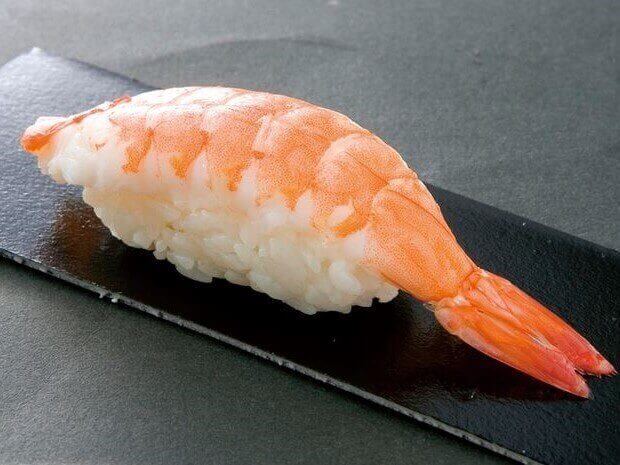 Japan leads the world in shrimp consumption by far. Most of the shrimp is imported, but it is a little known fact that shrimp is called “Meki” among importers and sushi restaurants in Japan. It is said to be a remnant from a time when much of the imported shrimp came from Mexico (pronounced “Mekishiko” in Japanese).
Japan leads the world in shrimp consumption by far. Most of the shrimp is imported, but it is a little known fact that shrimp is called “Meki” among importers and sushi restaurants in Japan. It is said to be a remnant from a time when much of the imported shrimp came from Mexico (pronounced “Mekishiko” in Japanese).
Shrimp can be caught within 45 degrees north or south of the equator. The caught shrimp is quick-frozen on site and then sent to Japan. Mexico was early in advanced refrigeration technology so when it became impossible to catch shrimp in the seas around Japan in the 1970s, a large volume of shrimp was already being imported from Mexico. It was around that time that importers shortened the phrase “Shrimp imported from Mexico” to “Meki”.
After that the major source of shrimp imports switched to Taiwan, which started shrimp aquaculture, and it is now also imported from Thailand, Indonesia and China. The name “Meki” stuck in the industry, despite the fact that shrimp is now mainly imported from other places in Asia.
Imported shrimp is categorized by body color tones, either brown, pink or white. The color is combined with the place of origin or country name and that is what each type of fish is called at the distribution stage. For example, they may be called Mexico brown or Guiana pink.
Well-known brown-toned shrimp include Ushi ebi (Black tiger shrimp) and Mexico brown (Yellowleg shrimp). Pink-toned types include Guiana pink (Pink spotted shrimp) and Nigeria pink ebi (Southern pink shrimp). White-toned shrimp include Taisho ebi (Fleshly prawn), Banana ebi (Banana Prawn) , Eedeavour ebi (Eedeavour prawn) and Vannamei ebi (Whiteleg shrimp). There are many sushi restaurants that use pink and brown-toned sushi that turn into a nice red color when boiled. While the meat of white-toned shrimp is soft, it turns a whitish color when boiled and doesn’t look very appetizing. However, due to the splendid, large tail, it is perfect for tempura or fried prawns.
Next, We will touch on the characteristics of shrimp that is typically imported to Japan. All these types are actually related to the Kuruma prawn, which is representative of premium shrimp and a familiar ingredient of sushi. In other words, these imports are alternatives to make up for the shrimp consumption in Japan that can’t be covered by the Kuruma prawn. Normally the head is removed, it is frozen, packed in large lots, and then embarks on the distribution channel in Japan.
There are about 27 species of kuruma prawns (Penaeus japonicus Spence Bate, 1888). The following is a list.
Crystal shrimp: Farfantepenaeus brevirostris (Kingsley, 1878)
Witch Shrimp: Farfantepenaeus Burukovsky, 1972
Northern pink shrimp: Farfantepenaeus duorarum (Burkenroad, 1939)
Indian white prawn (Shonanebi): Fenneropenaeus indicus (H.Milne Edwards, 1837)
Caramote Prawn: Penaeus kerathurus (Forskål, 1775)
Western king prawn (Futomizoebi): Penaeus latisulcatus Kishinouye, 1896
Redspot King Prawn: Penaeus longistylus Kubo, 1943
Aloha Prawn (Terao-kurumaebi): Penaeus marginatus J.W.Randall, 1840
Western White Shrimp (Tenjiku-kurumaebi): Penaeus occidentalis Streets, 1871
San Paulo Shrimp: Penaeus (Melicertus) paulensis Pérez Farfante, 1967
Redtail Prawn (Akaoebi): Penaeus penicillatus Alcock, 1905
Southern White Shrimp: Penaeus schmitti Burkenroad, 1936
Green Tiger Prawn (Kumaebi): Penaeus semisulcatus De Haan, 1844
Northern White shrimp: Penaeus setiferus (Linnaeus, 1767)
-: Penaeus silasi Muthu & Motoh, 1979
Blue Shrimp (Paradise prawn or Theshinoebi): Penaeus stylirostris Stimpson, 1874
Southern Brown Shrimp: Penaeus subtilis Pérez Farfante, 1967
The following is a list of those commonly used in sushi restaurants and Japanese restaurants in Japan.
Guiana pink (Redspotted shrimp, Spotted pink shrimp /Farfantepenaeus brasiliensis (Latreille, 1817))
For more information, go here.
Taisho ebi (Fleshly prawn /Fenneropenaeus chinensis (Osbeck, 1765))
It is found from the Indian Ocean to the Pacific Ocean, the Malay Archipelago and Australia. The species is of considerable commercial importance in the Yellow Sea, East China Sea and Korean Bight, where it is trawled. It is sold in Korea, China, Japan and Hong Kong. This is a large shrimp that reaches up to 25 cm in body length. The appearance is similar to the Kuruma ebi, but without any special pattern. The edge of the abdomen is a dark brown color. There are 28 known species related to the Kuruma ebi. In the Toyosu market, those with a striped pattern are Kuruma ebi, and those without are Taisho ebi. In Japanese it’s been dubbed “Korai ebi” is due to the fact that it is often caught in the waters off the west coast of the Korean peninsula. The soft meat has a sweetness that makes this shrimp delicious. The number of wild Taisho ebi has decreased drastically in recent years. The coloring is lighter than Kuruma prawn and Black tiger shrimp, but darker than other white-toned shrimp. This type has a long history compared to other imported frozen shrimp and such high volumes were imported from China that it was called Chinese Taisho. It accounted for the majority of the market share until farmed Black tiger shrimp started to appear on the market.
Banana ebi (Banana Prawn /Penaeus merguiensis De Man, 1888)
It found around the northern coast of Australia from the New South Wales-Queensland border to Shark Bay in Western Australia, it is mainly caught by trawlers between Exemouth Gulf, Western Australia and Brisbane, with the bulk of the catch coming from the Gulf of Carpentaria. It weighs between 18 to 30 g per shrimp and is colored like a banana. The meat is soft and has a sweetness. Sometimes it is also sold as Taisho ebi. The body is thinner and slenderer than the Black tiger shrimp. It is available year round with peak supply in April.
Mexico brown (Yellowleg shrimp, Brown shrimp /Farfantepenaeus californiensis (Holmes, 1900))
For more information, go here.
Vannamei ebi (Whiteleg shrimp, Pacific white shrimp/Litopenaeus vannamei (Boone, 1931))
For more information, go here.
Ushi ebi (Black tiger shrimp, Giant tiger prawn/Penaeus monodon Fabricius, 1798)
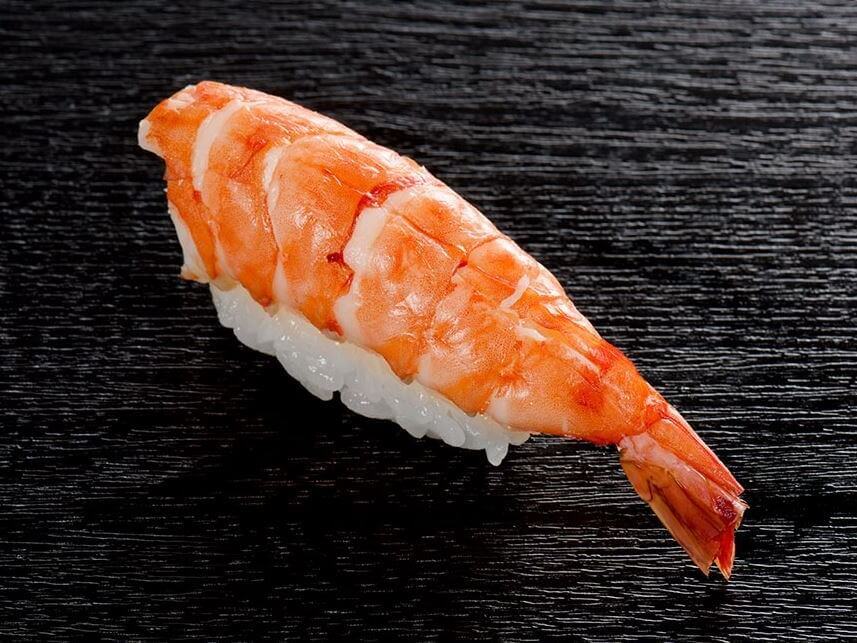
For more information, go here.
Australia tiger (Brown tiger prawn /Penaeus esculentus Haswell, 1879)
The Australian tiger (Brown tiger prawn) is endemic to Australia and is found at depths of 15~20 meters along the coast except in the southern part of the country. Its main locality is the Gulf of Carpentaria on the northern coast of Australia. It reaches 25 cm in length but is generally 15~20 cm long.
Because of its beautiful red legs and reddish-brown stripes, this shrimp is mainly imported to Japan with its head on. In addition to its shape and size reminiscent of Kuruma ebi, it is a high-end variety that is not so tough, sweet, and has a good taste and coloration and is used in grilled dishes and tempura.
Nigeria pink ebi (Southern pink shrimp, Candied shrimp/Farfantepenaeus notialis (Pérez Farfante, 1967))
Nigeria pink ebi (Southern pink shrimp) is found from Mauritania to Angola at depths of 20~100m. It is also found in the western Atlantic Ocean from the Caribbean coast to southern Brazil.
It inhabits bottom mud or sandy mud, and sandy patches among rocks in marine environments. Juveniles are found in estuarine environments. Also inhabits lagoons. It is often used for sushi because of the soft meat, good flavor, and nice coloring. This is one of the highest grades of imported shrimp.
Mexico ebi (Northern brown shrimp, Brown shrimp /Farfantepenaeus aztecus (Ives, 1891))
Mexico ebi (Northern white shrimp) is distributed from the Gulf of Mexico to depths of up to 30 meters along the eastern coast of North America. Juvenile shrimp grows in estuaries. It is the most important species in the Gulf of Mexico, with an average annual catch of nearly 30,000 tons. On the other hand, Southern white shrimp is distributed in shallow waters from the Caribbean Sea to southern Brazil. It is almost indistinguishable from this species in appearance, but the male and female reproductive organs differ in shape.
Maximum standard length: 22 cm. It lives in bottom mud or peat, often with sand, clay, or broken shells. Adults inhabit the marine environment. Juveniles inhabit the estuarine and marine environments. There are 13 types of brown-toned Kuruma prawn in the world and the names get confusing.
Also called Golden Shrimp, Red Shrimp, Redtail Shrimp.
King ebi (Eastern king prawn /Penaeus plebejus Hess, 1865)
Adults are found in marine environments while juveniles are found in estuarine environments. It is found over sandy bottoms at depths of 2-350 m or deeper.
Finally, the shrimp introduced in this section is consumed not only in Japan but all over the world. Judging by the images on social media, takeout sushi and the frozen shrimp sold at Costco are made from one of the types of shrimp described here. If you’re going to learn about sushi, it’s important to learn the types of shrimp used in sushi.
India ebi (Indian prawn/Madagascar white prawn/Fenneropenaeus indicus (H.Milne Edwards, 1837))
India ebi (Indian prawn) is widely distributed from the Philippines through Southeast Asia to the western Indian Ocean. It is especially important in the waters from the Indian coast to the western Indian Ocean.
It is a White species of Kuruma ebi and is similar in appearance to the Banana Prawn. Once the head is removed, it is difficult to distinguish between the two species. In Southeast Asian markets, both species are sold together.
Those distributed in East African waters have brownish bodies and reddish legs. It has a rich flavor and aroma and is very tasty. It is suitable for frying and tempura.
Also called Indian white prawn, Tugela prawn , White prawn.
Endeavour ebi (Endeavour prawn/ Metapenaeus endeavouri (Schmitt, 1926))
Endeavour ebi (Endeavour prawn) are abundant in all waters except the southern part of Australia, but can also be caught in Philippine waters. It is found at depths of 20 to 45 meters. It is said to be caught together with shiba shrimp in some waters, but unlike shiba shrimp, it does not enter brackish water.
It is about 15 cm long and weighs about 17 grams. The entire body is covered with fine hair. Its scientific name is derived from the name of a research vessel, the Endeavour, which surveyed the eastern coast of Australia.
Also called Brown prawn, Endeavour shrimp.
[sc_apply url=”https://sushiuniversity.jp/apply/”]
We hope this information will be helpful.

Revision date: June 15, 2024
Share this article
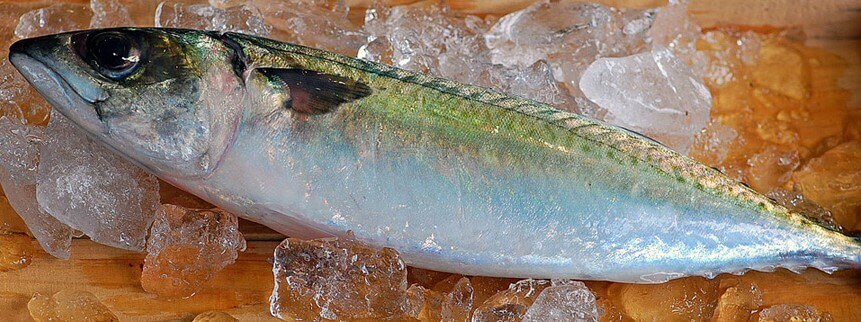
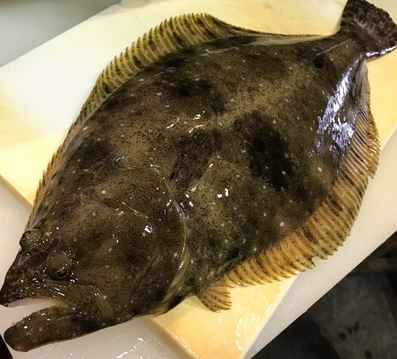 Hirame is a high-quality fish that goes for at least US $50 per kilogram. It can even exceed US $80 per kilogram, depending on the timing and the fish’s body.
Hirame is a high-quality fish that goes for at least US $50 per kilogram. It can even exceed US $80 per kilogram, depending on the timing and the fish’s body.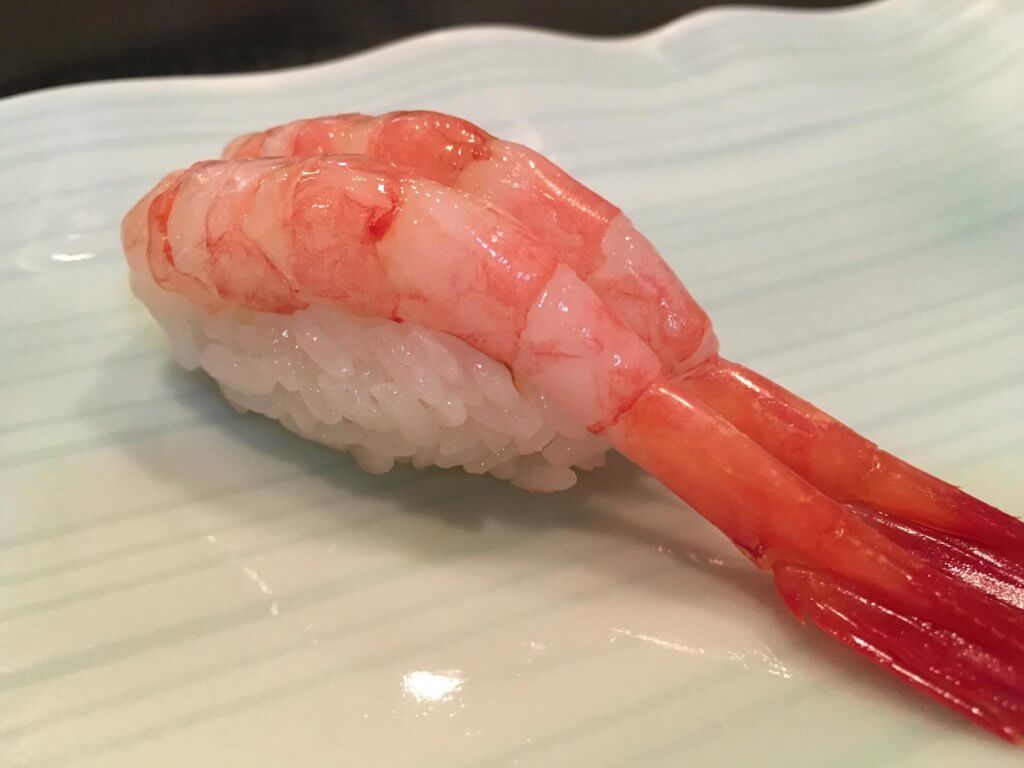 It goes without saying, that each type of fish has its very own scientific name. However, in places like the Toyosu Fish Market, there are seafoods that end up sharing a name.
It goes without saying, that each type of fish has its very own scientific name. However, in places like the Toyosu Fish Market, there are seafoods that end up sharing a name.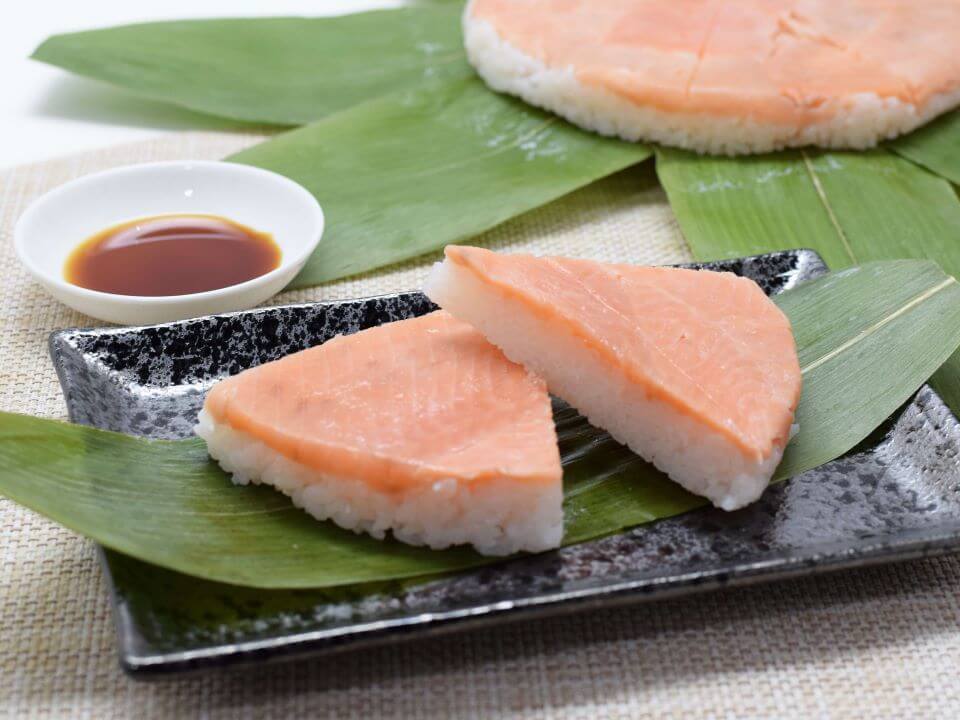 The origin of Masuzushi dates back about 300 years. Apparently, in 1717 it was first presented as Ayu narezushi (narezushi is a traditional food, said to be the original form of sushi and made from lactic fermentation of fish) to the third-generation feudal lord, Toshioki Maeda, by Shinpachi Yoshimura, a feudal retainer of Toyama who excelled in cooking skills. Toshioki liked the dish very much and assigned the role of vinegaring Ayu to Shinpachi. After that, it is said that the same narezushi was presented to the eighth shogun of the Tokugawa shogunate, Yoshimune Tokugawa, and that Yoshimune was extremely pleased with it.
The origin of Masuzushi dates back about 300 years. Apparently, in 1717 it was first presented as Ayu narezushi (narezushi is a traditional food, said to be the original form of sushi and made from lactic fermentation of fish) to the third-generation feudal lord, Toshioki Maeda, by Shinpachi Yoshimura, a feudal retainer of Toyama who excelled in cooking skills. Toshioki liked the dish very much and assigned the role of vinegaring Ayu to Shinpachi. After that, it is said that the same narezushi was presented to the eighth shogun of the Tokugawa shogunate, Yoshimune Tokugawa, and that Yoshimune was extremely pleased with it.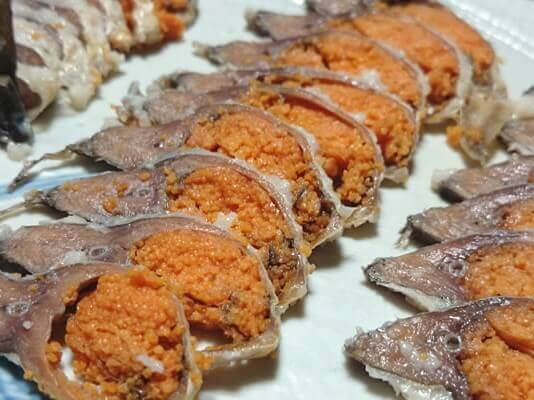 Narezushi (mainly a preserved food in which fish undergoes lactic fermentation with salt and rice), in which Sushi finds its roots, can still be found even today throughout Japan. The most famous is Funazushi (鮒寿司, 鮒鮓, 鮒寿し) in Shiga prefecture.
Narezushi (mainly a preserved food in which fish undergoes lactic fermentation with salt and rice), in which Sushi finds its roots, can still be found even today throughout Japan. The most famous is Funazushi (鮒寿司, 鮒鮓, 鮒寿し) in Shiga prefecture.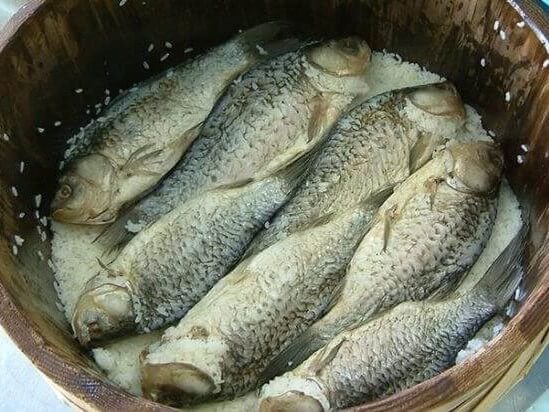 Making Funazushi sushi is surprisingly simple. The only ingredients are crucian carp caught in
Making Funazushi sushi is surprisingly simple. The only ingredients are crucian carp caught in 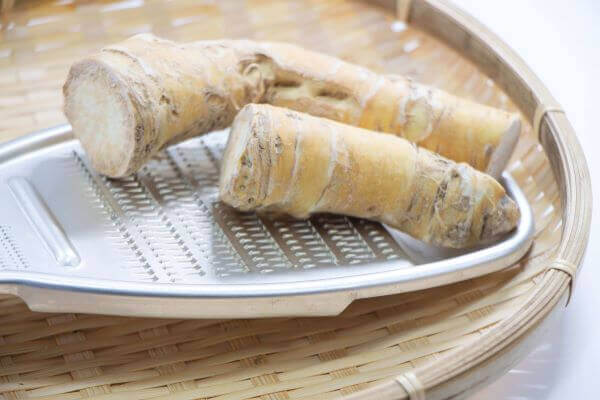
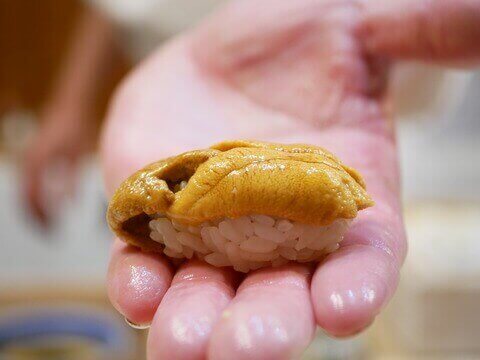 In Japanese, when a compound word is made out of two individual words, and the first consonant of the second word changes from a “clear sound” to a “fuzzy sound”, it is called “Rendaku”. For example, Edomae (江戸前) + sushi (寿司) changes to Edomaezushi (江戸前寿司). However, the correct pronunciation is only generalized among Japanese people, so in this book we chose the most commonly searched version of each compound word.
In Japanese, when a compound word is made out of two individual words, and the first consonant of the second word changes from a “clear sound” to a “fuzzy sound”, it is called “Rendaku”. For example, Edomae (江戸前) + sushi (寿司) changes to Edomaezushi (江戸前寿司). However, the correct pronunciation is only generalized among Japanese people, so in this book we chose the most commonly searched version of each compound word.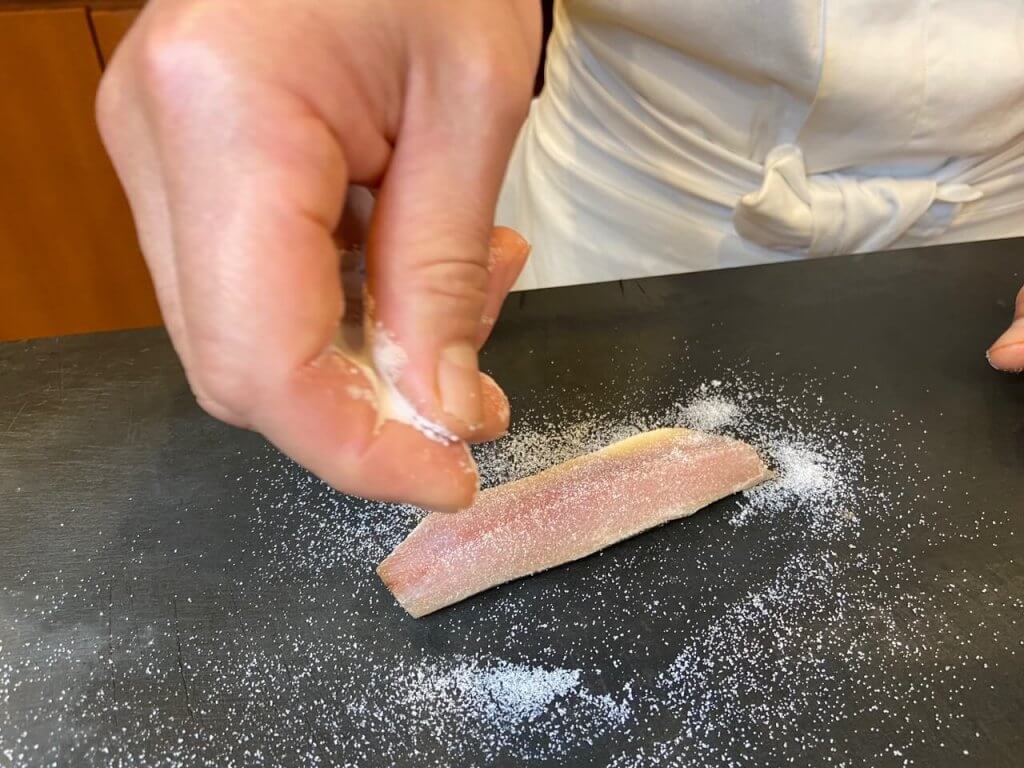
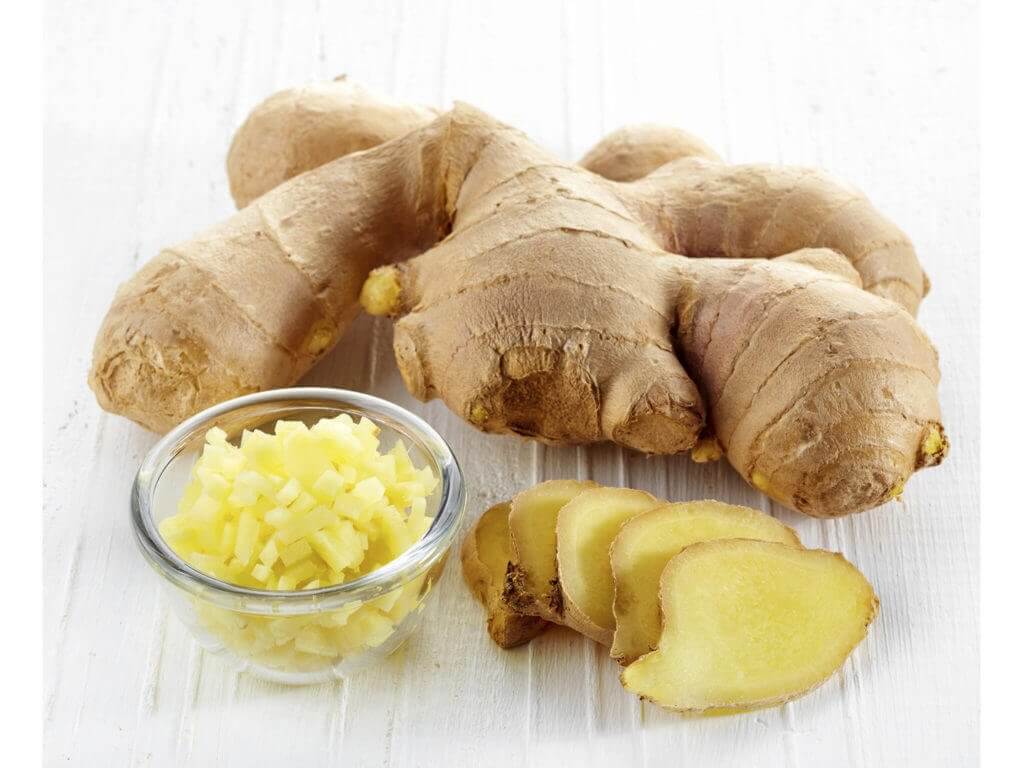 Sashimi essentials such as wasabi, ginger, karami-daikon, etc., are collectively called “Karami”. Originally Karami was a type of Tsuma. From the mid to late Edo period, Karashi (mustard) was mainly used for karami in sashimi. Eventually, due to the influence of Edomae sushi, wasabi became the norm. For sashimi such as bonito and sardines, wasabi isn’t enough to offset the peculiar aroma. In some cases, it is better to use ginger, which works on the root components of the odor. These types of fish have the best flavor once spring has passed, and interestingly enough, wasabi is least prevalent in summertime, while ginger is in peak season. Mother nature seems to know what she’s doing.
Sashimi essentials such as wasabi, ginger, karami-daikon, etc., are collectively called “Karami”. Originally Karami was a type of Tsuma. From the mid to late Edo period, Karashi (mustard) was mainly used for karami in sashimi. Eventually, due to the influence of Edomae sushi, wasabi became the norm. For sashimi such as bonito and sardines, wasabi isn’t enough to offset the peculiar aroma. In some cases, it is better to use ginger, which works on the root components of the odor. These types of fish have the best flavor once spring has passed, and interestingly enough, wasabi is least prevalent in summertime, while ginger is in peak season. Mother nature seems to know what she’s doing.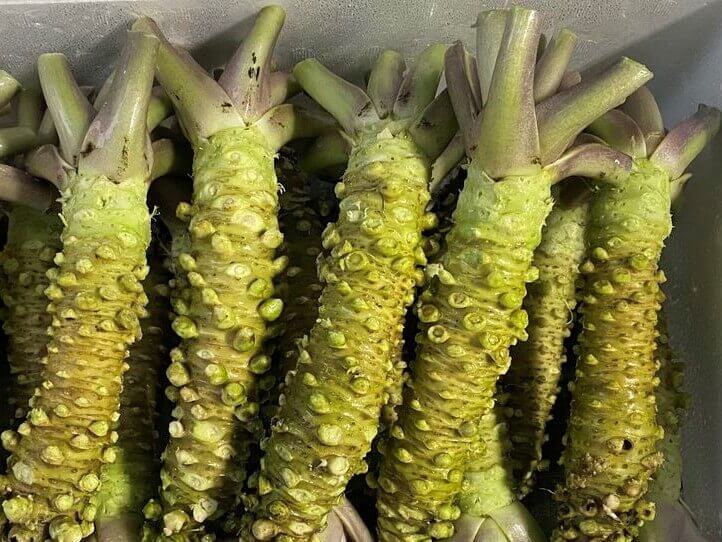 So, what is the true meaning of the shocking phrase, “Once you try tuna or flounder with this wasabi, you’ll never be able to eat it without wasabi again”?
So, what is the true meaning of the shocking phrase, “Once you try tuna or flounder with this wasabi, you’ll never be able to eat it without wasabi again”?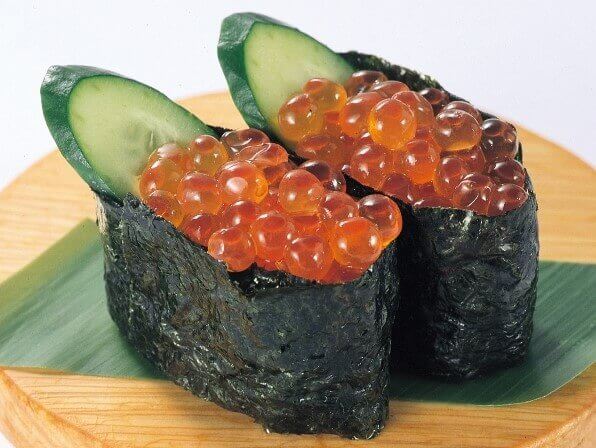 Immature salmon eggs still wrapped in ovarian membrane and salted are called sujiko. Ikura is salmon roe in which each mature egg is separated from the ovarian membrane before laying the eggs and then salted or marinated in soy sauce. The ikura of Chum salmon going upstream in the Kushiro River and Tokachi River in Hokkaido From October to December are considered to be premium ikura.
Immature salmon eggs still wrapped in ovarian membrane and salted are called sujiko. Ikura is salmon roe in which each mature egg is separated from the ovarian membrane before laying the eggs and then salted or marinated in soy sauce. The ikura of Chum salmon going upstream in the Kushiro River and Tokachi River in Hokkaido From October to December are considered to be premium ikura.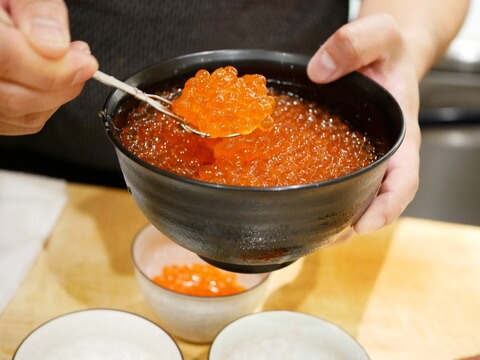 In Japan, salmon roe that has been separated from the ovarian membrane and then salted is called ikura. At sushi restaurants, this is also marinated in broth that includes soy sauce, mirin and sake. This is called ikura marinated in soy sauce, or simply ikura. Worldwide, caviar is considered to be of more value than ikura. Therefore, in an attempt to improve the impression of soy sauce-marinated ikura, it is sometimes called ‘salmon caviar’. This is behavior especially seen among manufacturers selling soy sauce-marinated ikura.
In Japan, salmon roe that has been separated from the ovarian membrane and then salted is called ikura. At sushi restaurants, this is also marinated in broth that includes soy sauce, mirin and sake. This is called ikura marinated in soy sauce, or simply ikura. Worldwide, caviar is considered to be of more value than ikura. Therefore, in an attempt to improve the impression of soy sauce-marinated ikura, it is sometimes called ‘salmon caviar’. This is behavior especially seen among manufacturers selling soy sauce-marinated ikura.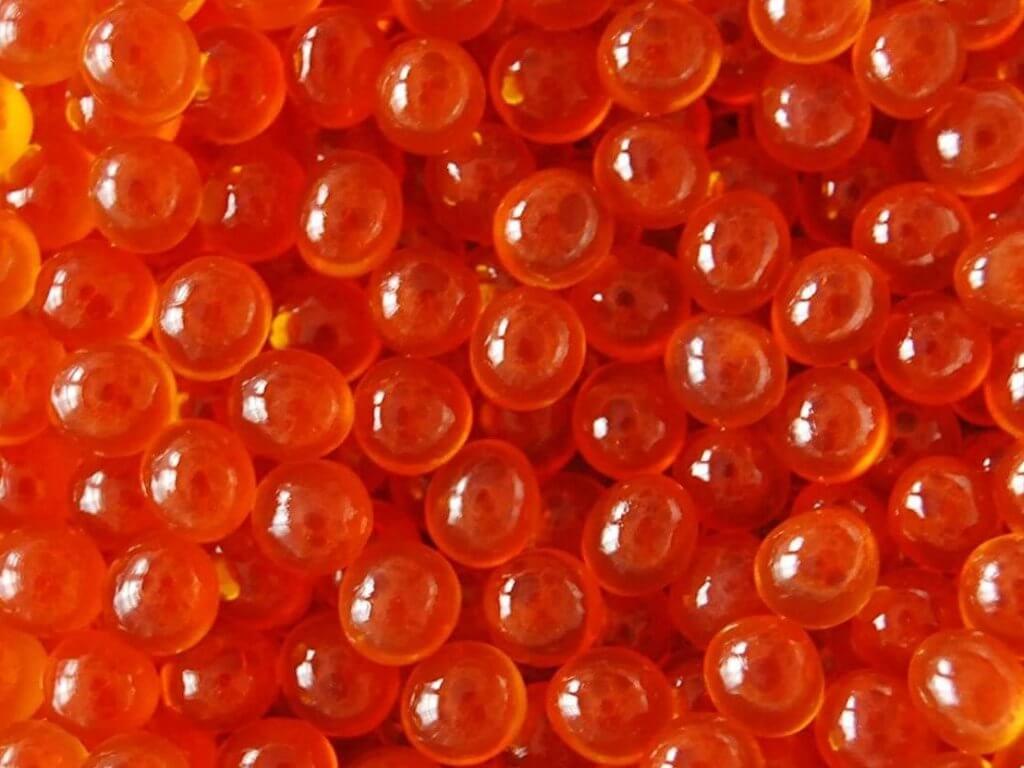 Not to belabor the point, but the following is dependent on the following. In Japanese salmon is referred to as “鮭” (sake/salmon) or “鱒” (masu/trout). The characters look different, but they are part of the same family and there aren’t clear biological categories to separate them into. Incidentally, in English the type that makes their way into the sea are called “salmon,” and those that remain in freshwater their entire lives are known as, “trout.” They are all considered to be part of the salmon family. Now, foreigners who know about Japan may imagine Japanese sake (the alcoholic beverage) when they hear the word “sake” so we spell sake/salmon as “shake”, which is close to the sound pronounced by Japanese people.
Not to belabor the point, but the following is dependent on the following. In Japanese salmon is referred to as “鮭” (sake/salmon) or “鱒” (masu/trout). The characters look different, but they are part of the same family and there aren’t clear biological categories to separate them into. Incidentally, in English the type that makes their way into the sea are called “salmon,” and those that remain in freshwater their entire lives are known as, “trout.” They are all considered to be part of the salmon family. Now, foreigners who know about Japan may imagine Japanese sake (the alcoholic beverage) when they hear the word “sake” so we spell sake/salmon as “shake”, which is close to the sound pronounced by Japanese people. Ken is considered to be better the longer and thinner it is, but this is a mistake. Not only is Ken tangled and difficult to eat, but it also doesn’t give any sense of the flavor of the materials. It’s long been said that 10 cm is a reasonable length and this is also the length that looks the most refined.
Ken is considered to be better the longer and thinner it is, but this is a mistake. Not only is Ken tangled and difficult to eat, but it also doesn’t give any sense of the flavor of the materials. It’s long been said that 10 cm is a reasonable length and this is also the length that looks the most refined.